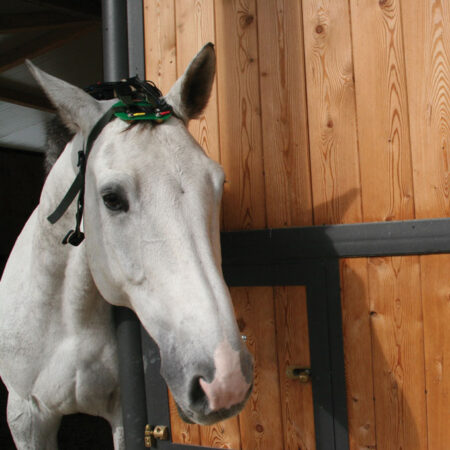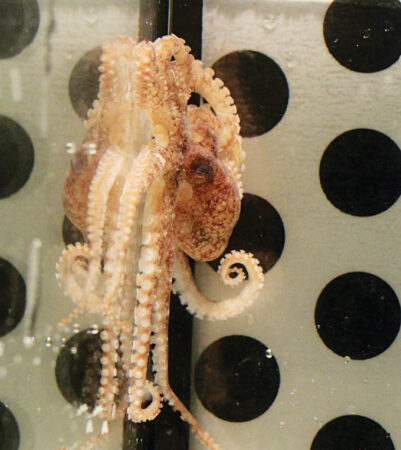A dog gives a protective bark, sensing a nearby stranger. A cat slinks by disdainfully, ignoring anyone and everyone. A cow moos in contentment, chewing its cud. At least, that’s what we may think animals feel when they act the way they do. We take our own lived experiences and fill in gaps with our imaginations to better understand and relate to the animals we encounter.
Often, our assumptions are wrong. Take horse play, for example. Many people assume that these muscular, majestic animals are roughhousing just for the fun of it. But in the wild, adult horses rarely play. When we see them play in captivity, it isn’t necessarily a good sign, says Martine Hausberger, an animal scientist at CNRS at the University of Rennes in France.
Hausberger, who raises horses on her farm in Brittany, began studying horse welfare about three decades ago, after observing that people who keep horses often misjudge cues about the animals’ behavior.
Adult horses that play are often ones that have been restrained, Hausberger says. Play seems to discharge the stress from that restriction. “When they have the opportunity, they may exhibit play, and at that precise moment they may be happier,” she says. But “animals that are feeling well all the time don’t need this to get rid of the stress.”
Scientists studying animal behavior and animal welfare are making important strides in understanding how the creatures we share our planet with experience the world. “In the last decade or two, people have gotten bolder and more creative in terms of asking what animals’ emotional states are,” explains Georgia Mason, a behavioral biologist and animal welfare scientist at the University of Guelph in Canada. They’re finding thought-provoking answers amid a wide array of animals.
For instance, recent studies hint that picking up a mouse by its tail casts a pall on the animal’s day, and that an unexpected sugar treat may improve a bee’s mood. Crayfish might experience anxiety; ferrets can get bored; and octopuses, and perhaps fish, can experience pain.
Such findings could drive changes in how we treat the animals in our care. For instance, a broad scientific review published in November 2021 by the London School of Economics and Political Science concluded that certain invertebrates such as crabs, lobsters and octopuses should be considered sentient — that is, capable of subjective experiences such as pain and suffering. The conclusions suggest that protection afforded by animal welfare laws should extend to these creatures. One possible outcome: Updates to U.K. animal welfare legislation may make it illegal to boil lobsters alive, requiring swifter, less painful methods to kill the animals.
Yet studying what animals experience is a challenge, says Charlotte Burn, an animal welfare scientist at the Royal Veterinary College in Hatfield, England, and an author of the 2021 review. Researchers can make scientific inferences about how an animal feels based on observable clues from physiology or behavior, she says. But feelings are subjective. “So doing science about this is a bit strange,” Burn says, “because you have to get comfortable with the fact that your key thing is unknowable.”

Horse sense
To study horse welfare, Hausberger doesn’t focus on how emotions such as happiness or sadness may manifest in any given moment. She’s interested in a horse’s overall emotional picture — as she puts it, “the chronic state of feeling more positive or negative emotions.”
To determine how content a horse is with its life, people who care for horses would typically look at things like ear position, posture and how attentive the horse is to its environment. Blood markers for anemia, indicating chronic stress, and signs of overall wellness such as appetite and immune system health could also shed light.
Recently, Hausberger and her colleagues tested a more specific and direct measure: the brain waves of horses, collected using electroencephalography, or EEG.
In people, EEG can help assess sleep patterns or diagnose conditions such as epilepsy, stroke or head injury, and researchers now think certain types of brain waves can indicate depression. EEG has been used in animals in veterinary clinics and in laboratory studies, but Hausberger wanted to bring the tool to the animals’ home turf.
Her team created a simplified, portable EEG device that provides “a sort of summary of brain activity,” she says. Five electrodes are placed on a horse’s forehead, attached to a lightweight headset.
The researchers used this headset EEG to gauge the welfare of 18 horses that wore the device for six 10-minute observations. The results, published March 2021 in Applied Animal Behaviour Science, give a snapshot into the secret lives of horses.

The horses that roamed with their herd outdoors, grazing at will, had more brain waves called theta waves, which have high amplitude and move slowly. In humans, theta waves are thought to reflect calm and well-being. By contrast, the animals that lived in solo stalls with little contact with other horses had more gamma brain waves, the fastest of all brain waves. In people, gamma waves are associated with anxiety and stress.
Shared evolutionary history
For most of the last two millennia, Western thinkers roundly rejected the notion that animals have the capacity for feelings. Charles Darwin bucked that trend, proposing a shared evolutionary capacity for emotion across species in his 1872 book, The Expression of the Emotions in Man and Animals. Take fear, for example: “With all or almost all animals, even with birds, Terror causes the body to tremble,” he wrote.
But a psychological theory called behaviorism, which gained prominence in the early 20th century, put a decades-long pall on research into animals’ inner lives. Behaviorists dismissed the prospect of studying subjective experiences, holding that “if you can’t measure it, don’t make up stories about it,” Mason says.
That started to change near the end of the 20th century. For example, in the 1980s, animal welfare researcher Marian Stamp Dawkins of the University of Oxford began probing how animals experience the world. Her studies gave creatures an opportunity to demonstrate what they wanted and how much of a cost they would pay to gain it. Researchers still ask such questions. For instance: How heavy a door would a hen push for the chance to perch at night?
Another approach involves investigating animals’ feelings through the lens of human psychology. Looking for parallels in how humans and other animals process experiences makes sense because our brains and behaviors reflect a shared evolutionary history, says Michael Mendl, an animal welfare researcher at the University of Bristol in England. Researchers routinely probe the minds and brains of rodents and other animals, including flies, fish and primates, to study and develop drugs for human mental disorders such as depression and anxiety. So we should be able to work backward from humans to study feelings in other animals too, Mendl says.

Mood matters?
Mendl and psychologist Elizabeth Paul, also at the University of Bristol, narrowed in on one well-known feature of human psychology. People’s emotional states, negative or positive, bias their thoughts and decisions. Psychologists use the term “affect” for these overarching mental states.
Affect acts as a filter through which one sees the world — rose-colored or turd-smeared glasses, you could say — that is often shaped by positive or negative experiences. Mendl, Paul and graduate student Emma Harding devised an experiment in the early 2000s that sought to parse whether experiences that might influence a rat’s affect can change the decisions it makes.
The researchers first taught the rats to associate one tone with a positive stimulus (a tasty treat) and another tone with a negative stimulus (an unpleasant noise). The rats learned to press a lever when they heard the positive tone, and not to when they heard the negative one. Then, the researchers placed the animals in either a pleasing, predictable living environment or an annoyingly variable one.
A few days later, for each animal, the researchers played a beep with a wavelength right between the positive and the negative tones. The animals that had lived in the pleasing cage pressed the lever, hinting that they were optimistic that pressing the lever would yield a treat. The ones that lived in the unpredictable cage left the lever alone, or were slower to press it, suggesting they were more pessimistic.
“What we think our test shows is that the animal is in a positive or negative affective state,” Mendl explains. To put it more plainly: The rats’ behaviors could mean that they judged the tone based on whether they felt good about the world. Since that study, researchers have used this task and variations of it to gauge positive and negative affect in at least 22 species, including mammals, birds and insects.
But there’s an important caveat, Mendl says. The experiment, called a judgment bias task, points to whether an animal is experiencing something in its life positively or negatively. However, the task doesn’t demonstrate something more basic — whether an animal can have subjective experiences to begin with.
Animal welfare studies assume that animals are sentient, because if they weren’t, talking about their well-being wouldn’t make sense, Mason says. “But none of the measures we use can assess or check that assumption, because we simply don’t yet know how to assess sentience,” she notes.
Searching for emotional life
Mason posits that some animal experiences are probably species-specific. For group-living animals like sheep, for example, “to be isolated probably induces a form of terror that … humans can’t imagine,” Mason says. Or, for creatures like homing pigeons that can sense magnetic fields, being put in a strong magnetic field “may be very upsetting in a way that we don’t have a name for,” she says.
But many other feelings could be shared. For example, a sizable body of evidence suggests that stressors from life in captivity can cause depression in animals. What about boredom?
Mason and her colleagues reasoned that a depressed animal would lose interest in its surroundings, but a bored animal might be drawn to both negative and positive stimuli, just to get a reprieve from monotony. That’s what the group showed in 2012. Male minks sought out pleasant experiences — like the smell of female poop, a treat during mating season — but also neutral ones like plastic bottles and even threatening ones like the big leather gauntlets farmers use to catch minks.
Building on Mason’s work, Burn, at Royal Veterinary College, recently found a similar dynamic in ferrets living in a lab. The animals sought out the pleasure of a good whiff of mouse bedding, as well as the distasteful smell of peppermint oil, and they tended to be both drowsy and restlessly aggressive.
Relieving the animals’ boredom with extra playtime turned their interests away from the negative, Burn and her colleagues reported in February 2020 in Animal Welfare.
Pain in two parts
Pain, too, is experienced by many animals. Pain has two components, says behavioral and welfare scientist Matthew Leach of Newcastle University in England. One component is physical, simply consisting of the activation of sensory receptors, nerve cells firing or other physiological features — pain’s plumbing, you could say. Animals respond to it with a reflex reaction or a basic learned response; no conscious awareness is required.
The other component is emotional, which is trickier to measure because it manifests in more complex behaviors. For example, mice, which like an ambient temperature up to 10 degrees Celsius higher than in most research labs, build intricate nests in their cages that help them regulate body temperature. When the animals are in pain or distress, their nest-building abilities fall apart.
Facial expressions are a more direct way to assess pain or other types of distress in animals, Leach says. His lab team and others have identified a range of expressions in more than a dozen species, from mice to horses. With less than 30 minutes of training, people can learn to accurately see grimaces in animals’ faces, Leach says.
Those faces can reveal more than pain. Using artificial intelligence algorithms to scan videos of mouse faces, researchers have identified a whole range of emotions — pleasure, disgust, fear — encoded in the tilt of the ears or a curl of the nose (SN: 5/9/20 & 5/23/20, p. 16). “We’re still very much in the infancy of understanding what facial expressions are telling us,” Leach says.
Researchers can often infer from an animal’s behavior that it is in pain, Leach says. But making such inferences about animals that are very different from us is more challenging. Take octopuses, for instance. Their three-lobed brain “is as far from a vertebrate as you could possibly ever get,” he says. That evolutionary distance may mean octopuses respond to stimuli differently.
To probe that question, Robyn Crook, a neuroscientist at San Francisco State University, used a learning task to show that octopuses might in fact experience the emotional component of pain, reporting the results on February 22, 2021, in iScience. She first let octopuses loose in a box with three rooms, and each octopus naturally gravitated to a room it preferred.

Then Crook injected the animals with either saline, a slightly painful stimulus (an under-the-skin injection of acetic acid, the acerbic agent in vinegar) or the painful acid along with a pain-relieving medicine. She then put the animals injected with acetic acid into the chamber they preferred most, and the ones injected with acetic acid and the pain killer into the chamber they had liked least. The idea was to allow the octopuses to associate how they felt with the chamber, Crook explains.
A few hours later, after the painful stimulus would have worn off, Crook let the animals explore the three rooms again. The octopuses that got the painful shots avoided their originally preferred room, suggesting they associated it with pain. Those that got the shots with the medicine now preferred the room they had originally disliked, suggesting they associated it with relief from pain. Matching their negative experience in the room with their later experience out of it requires a kind of “mental time travel” that hints at emotional awareness, Crook says. Not everyone agrees with this interpretation. “It is very difficult to produce convincing evidence of affective state in an animal that’s very unlike us,” she says — at least in part because of how mammalian-centric our assumptions tend to be.
A matter of ethics
Still, notes Mason, from an ethical and practical point of view, being cautious and treating octopuses as if they do feel pain “is wise and humane.” But researchers are still figuring out where to draw the line across the animal kingdom.
That question prompted the recent U.K. scientific assessment of sentience. The researchers involved reviewed all the literature they could find that might point to clues about the inner lives of cephalopods and crustaceans — studies on behavior and physiology, neuroanatomy and common practices in the seafood industry.
The group’s eight-point checklist considered factors such as whether an animal’s nervous system could integrate different types of sensory information, and the complexity of the animal’s pain-sensing machinery.
“There’s a lot of information out there about animal behavior that is actually relevant to questions of sentience in a way that hasn’t always been appreciated,” says report author Jonathan Birch, a philosopher of science at the London School of Economics and Political Science. But for these species, “there’s not been a lot of intentional investigation.”
Ultimately, says Burn, the group hedged its bets — not because they were sure, but because “the body of evidence is starting to make us think [the animals] deserve the benefit of the doubt,” she says. As researchers settle on ways to parse different emotional states — and on a more basic level, perhaps even ways to identify sentience — we might find a wider basis for a shared inner life across the animal kingdom.



